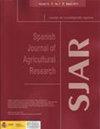Dynamics of carbon budget and meteorological factors of a typical maize ecosystem in Songnen Plain, China
IF 0.8
4区 农林科学
Q3 AGRICULTURE, MULTIDISCIPLINARY
引用次数: 0
Abstract
Aim of study: Understanding the carbon budget and meteorological factor impacts of farmland ecosystems is helpful for scientific assessment of carbon budget and low-carbon agricultural production practices. Area of study: The Songnen Plain, NE China, in 2019. Material and methods: Based on eddy-related flux and soil heterotrophic respiration observations from a typical maize farmland ecosystem, using mathematical statistics and carbon balance equation methods, were analyzed. Main results: Soil respiration rate (Rs) and composition were influenced and controlled by the synergistic effect of surface soil temperature (Ts) and water content (Wcs). Ts played a leading role, while Wcs played an important role. Ts and Wcs had the greatest influence on the heterotrophic respiration rate (Rh), followed by Rs and autotrophic respiration rate (Ra). Daily variations of net ecosystem productivity were correlated with daily mean air temperature, latent heat flux, and sensible heat flux. Annual carbon revenue was 1139.67 g C m-2, annual carbon expenditure was 456.14 g C m-2, and annual carbon budget was -683.53 g C m-2 in 2019. While considering that maize grain yield (-353.44 g C m-2) was moved out of the field at harvest, the net ecosystem carbon balance was -330.09 g C m-2; then it was carbon sink in 2019. By fully utilizing climate resources and improving agricultural managements, carbon sink is increased in farmland ecosystems. Research highlights: Soil respiration rate and composition were influenced and controlled by the synergistic effect of soil temperature and water content; the maize farmland ecosystem is carbon sink.松嫩平原典型玉米生态系统碳收支动态及气象因子分析
研究目的:了解农田生态系统的碳收支和气象因子影响,有助于科学评价碳收支和低碳农业生产实践。
研究区域:2019年中国东北松嫩平原[j]
材料与方法:基于典型玉米农田生态系统涡旋相关通量和土壤异养呼吸观测资料,采用数理统计和碳平衡方程方法进行分析。
主要结果:土壤呼吸速率(Rs)和土壤成分受表层土壤温度(Ts)和含水量(Wcs)的协同效应影响和控制。t起主导作用,Wcs起重要作用。Ts和Wcs对异养呼吸速率(Rh)的影响最大,其次是Rs和自养呼吸速率(Ra)。净生态系统生产力的日变化与日平均气温、潜热通量和感热通量相关。2019年年度碳收入为1139.67 g C m-2,年度碳支出为456.14 g C m-2,年度碳预算为-683.53 g C m-2。考虑玉米产量(-353.44 g C m-2)在收获时移出田间,生态系统净碳平衡为-330.09 g C m-2;然后是2019年的碳汇。通过充分利用气候资源和改进农业管理,增加农田生态系统碳汇。
研究重点:土壤呼吸速率和组成受土壤温度和含水量的协同效应影响和控制;玉米农田生态系统是碳汇。
本文章由计算机程序翻译,如有差异,请以英文原文为准。
求助全文
约1分钟内获得全文
求助全文
来源期刊

Spanish Journal of Agricultural Research
农林科学-农业综合
CiteScore
2.00
自引率
0.00%
发文量
60
审稿时长
6 months
期刊介绍:
The Spanish Journal of Agricultural Research (SJAR) is a quarterly international journal that accepts research articles, reviews and short communications of content related to agriculture. Research articles and short communications must report original work not previously published in any language and not under consideration for publication elsewhere.
The main aim of SJAR is to publish papers that report research findings on the following topics: agricultural economics; agricultural engineering; agricultural environment and ecology; animal breeding, genetics and reproduction; animal health and welfare; animal production; plant breeding, genetics and genetic resources; plant physiology; plant production (field and horticultural crops); plant protection; soil science; and water management.
 求助内容:
求助内容: 应助结果提醒方式:
应助结果提醒方式:


